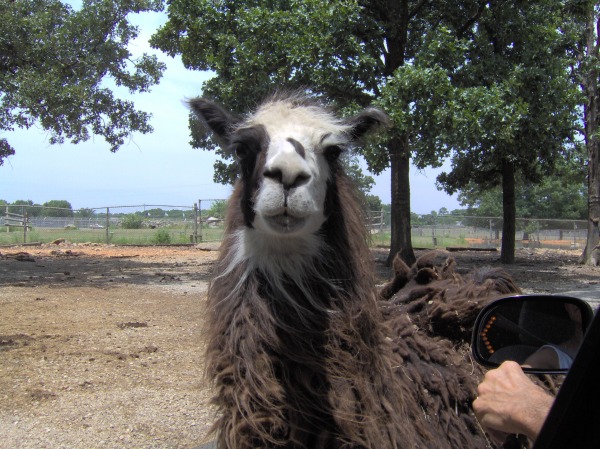
Vocabulary
maize - corn
obsidian - sharp, glasslike volcanic rock
observatories - buildings to study astronomy
causeways - raised roads across water or wet ground
conquistadors - Spanish soldiers
codex - ancient book of historical records; made of bark or animal skins
Quechua - official language of Incas
llama - incredibly cute animals that are related to camels but native to South America
masonry - stonework
mita - labor tax system
chinampas - floating gardens built in Tenochtitlán
calpulli - community of families that shared land, schools, and a temple; had one elected leader who followed orders from a king
Important People
Pacal (603-683) - Maya king who had a temple built in the city of Palenque to record his achievements as a ruler; became king at twelve years old
Moctezuma II (1466-1520) - Last Aztec emperor; ruled empire at it's height, but contributed to its downfall (scroll down to Fall of Aztecs)
Hernan Cortéz (1485-1547) - Spanish conquistador; went to Mexico in search of gold and conquered Aztec Empire (see Fall of Aztecs)
Pachacuti (died 1471) - Inca ruler who expanded territory, had capital at Cuzco rebuilt, and established an official Inca religion
Atahualpa (1502-1533) - Last Inca king (To learn more, scroll down to Fall of Incas)
Francisco Pizarro (1475-1541) - Spanish conquistador who conquered the Inca Empire (see Fall of Incas)
Malintzin (c.1501-1550) - Cortez's companion and interpreter; helped in Spanish conquest of Aztec Empire
Popol Vuh - Book which held Mayan legends and history

Geography and Tenochtitlán
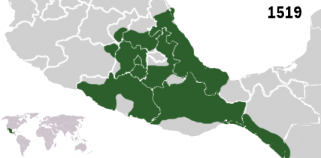
The earliest Aztecs were farmers from northern Mexico. When they moved south to settle in central Mexico, they found most of the good farmland taken. Determined to expand their lands, they became skilled warriors, and had soon conquered many towns. They even made allies with two other tribes on Texcoco Lake, and took over the rest of the lake. They built their capital on an island on that lake, and named it Tenochtitlán. It was very hot and humid, but the soil was great for crops. They had to built a stone aqueduct (like the Romans) to transfer fresh water to their island city, for the lake water was too salty to drink. To improve farming, they built chinampas, which were floating gardens, built out of soil laid on top of rafts. Tenochtitlán was one of the greatest city of the Americas, with over 2000,000 people, and great temples, busy markets, and a beautiful palace.
Religion
The Aztecs believed that gods controlled all parts of their life, and that the god's powers were demonstrated through either nature or people. As such, the Aztecs were constantly trying to please their gods. Their main form of appraisal was sacrifice. They believed that blood would "feed" the gods. They actually sacrificed over 10,000 people a year, some of them prisoners from other tribes, and others their own people. They worshiped Huitzilopochtli (the sun god) and Tlaloc (the rain god) the most. Since Huitzilopochtli made the sun rise, and Tlaloc made the rain fall, crops would not survive without the gods' assistance. Aztecs, therefore, devoted their lives to pleasing their gods.
Achievements
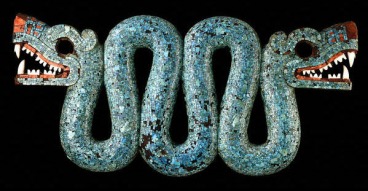
Science - chinampas; colorful calendar that told them best days for ceremonies or harvesting crops; used plants for medicine
Art - turquoise mosiacs (one above in two headed serpent that was worn during ceremonies
Architecture - built out of stone; temples, bridges, canals
Writing - codex; lots of oral stories and riddles
Social Structure
Kings - ruled empire; in charge of law, tribute, and warfare; lived in luxury in a palace with a zoo, garden, and aviary
Nobles - assisted king with; sometimes tax collectors or judges; went to special schools to learn responsibilities of government officials, military leaders, or priests
Priests - kept calendars that decided when to plant crops or perform ceremonies; passed down history and stories; performed religious ceremonies, like human sacrifice
Warriors - conquered new lands and people, which brought more tribute to the empire; granted many privileges
Merchants - gathered goods from all over Mesoamerica and sold them in markets; very rich- built expensive houses and sent sons to special schools
Artisans - made goods like headdresses and jewelry that was sold at an extremely high price; also very wealthy
Farmers - most of population; hired to grow maize and beans on other people's land
Slaves - horribly mistreated; sold to nobles or merchants to do the dirty work; sacrificed to gods if disobedient
Economy
One of the main forms of economy in the Aztec society was tribute. When civilizations were captured, they were forced to pay tribute, in the way of cotton, gold, or food. Basically, War + Trade + Tribute = Rich Aztecs!
Fall of Aztecs
When Hernan Cortez arrived in Mexico, Moctezuma thought he was a god, and therefore sent Cortez lots of gifts. Cortez went to the Aztec capital, and Moctezuma welcomed Cortez. In the hope of getting more gold, Cortex captured the emperor, causing the Aztecs to attack. In all the hubbub, poor Moctezuma was killed. You might be wondering how a powerful empire was conquered by a few conquistadors. Well, there are four main factors:
*Alliances - Malintzin, who was American Indian woman who translated for Cortez
*Weapons - swords, guns, canons, armor, horses
*Geography - With the capital being on an island, Cortez blocked Tenochtitian's causeways, bridges, and waterways, which cut off all food and water supplies
*Disease - smallpox

Geography and Machu Picchu
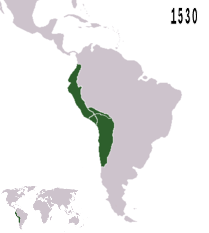
Inca territory was located in modern day Ecuador, Peru, Bolivia, Chile, Colombia, and Argentina. They began as a small tribe in the Andes, with Pachacuti as their ruler. His name actually means "He who remakes the world", so it was fitting that he was the one who greatly expanded the Inca Empire. By the early 1500s, Incas could live in coastal deserts, snowy mountains, fertile valleys, or thick forests. Even though their capital was Cuzco, the Inca's greatest city was Machu Picchu. It was built as a royal retreat for rulers, though festivals were often held in honor of gods, and there were food storage buildings as well. To keep lower class people out, there was only one door, for going both in and out. There were roughly some 200 buildings, many of which still stand today.
Religion
The Incas had their own religion, established by Pachacuti. It focused on many different gods. One of the main ones was the sun god. Priests performed ceremonies every winter to tie down the sun to keep it from disappearing completely. They also believed that all of their leaders were related to the sun god. Because of this, they never really died. They were mummified and brought to ceremonies, where they were given food and asked for advice. Religion also included sacrifice, though it was mainly of llamas, clothes, or food.
Achievements
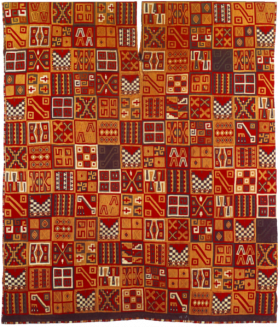
Building - high quality masonry; many buildings still being used
Roads - system of roads that connected all parts of the Empire; less than six feet across; followed natural features; travelers sent messages by running then passing it on to the next runner
Art - gold and silver jewelry; life size field of corn made out of gold; textiles (see picture)
Oral Literature - official "memorizers" learned poems about Inca history and legends; learned to speak Spanish from conquistadors, so they then wrote down their songs and religious practices
Quipu - form of written language with cords tied with knots; recorded numbers and calendars; different colors
Food - Incas learned to preserve potatoes by freezing them
Economy
Incas used a form of labor tax system called mita, where people payed in labor, instead of taxes. This was enforced by the government, in which they told each specific household what to do. Most families were farmers, living outside of Machu Picchu's walls. They grew maize and peanuts in the valleys, and raised llamas in the mountains. They also had to produce cloth and grain for the army. For those who were not farmers, they worked in mines or in the army. And, unlike other early civilizations, there were no markets or merchants. Goods were instead delivered through the help of the mita.
Social Structure
Upper Class - king, priests, government officials; lived in stone houses in Cuzco, where their sons went to school; didn't have to pay labor tax; had servants; wore fine clothes
Lower Class - farmers, artisans, servants (no slaves); farmed on government land, served in army, worked in mines, or built roads; by law, they couldn't own more goods than they needed
Fall of Incas
The Inca Empire first started its decline during the civil war, in which Athualpa and Huascar fought for the crown. In the end, Athualpa won, but it greatly weakened all of Inca's armies. Then a man named Pizarro came to Peru. After planning to meet the new king, he told him to convert to Christianity. Athualpa refused, and the Spaniards attacked. They captured the Inca leader and killed most of their troops. To try to gain his freedom, he filled a room full of gold, but Pizarro killed Athualpa anyway. The Inca Empire came to an end because of internal problems, Spanish army advantages, and other factors.
Compare & Contrast - Aztecs vs. Inca
Similarities--
*conquered by Spaniards
*Cortes and Pizarro captured leaders of each empire
*fell because of disease, internal problems, their leaders were captured, and military advantage for the Spanish (Wow, can you see how history repeats itself?)
*both Spanish leaders came looking for gold
*worshiped hundreds of gods
*one of the most important gods was the sun god
Differences--
*Aztecs owned slaves
*Incas had no merchants, only mita
*Warriors were not separate on the social structure for Inca - part of mita
*Incas had government officials instead of nobles, though they sometimes were the same thing
*Aztecs sacrificed over 10,000 people a year, while Incas only sacrificed llamas, clothing, and food...and sparingly
*Tribute (cotton, gold, food) for Aztecs vs. Mita (labor) for Incas

Geography
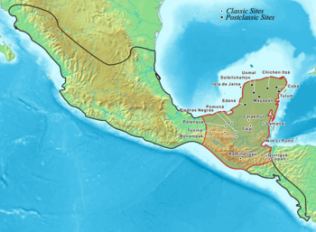
In the beginning of the Mayan Empire in 1000 BC, most of the land was covered by thick forests, and it was only through people clearing areas that they were able to farm. But the forests served as a resource to the Mayas, too. Deer and monkeys lived in the trees, and were used for food. Also, the wood could be used to build houses, along with vines and mud. At the height of its power between AD 250 and 900, their small villages grew to massive cities with up to 50,000 people each. Scientists call this time the Classic Age. If you look at the map, the red outlines the Mayan territories, and some of the major cities. For a close up of the map, please click here.
Religion
Mayan religion, like most other religion's of the time, was polytheistic. The most important god was the creator, but other ones included the sun god, moon goddess, and maize god. Mayans believed that their kings could communicate with the gods. Mayas used sacrifice as the main way to please the gods, for they thought that blood helped them prevent disasters. Everyone had some sort of piercing, and they held blood-fests for births, weddings, and funerals. A priest would even offer a human heart to stone carvings of gods.
Achievements
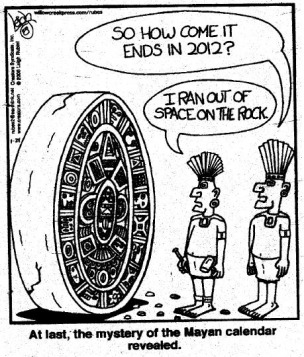
Art - sculptures of jade for gods and kings; gold jewelry
Architecture - giant cities mae out of limestone, with obsidian tools
Science - observatories - learned about the cycles of the moon and how to predict eclipses
Calendars - extremely colorful and accurate; based off of astronomy; year with 365 days
Math - number system; first people to use concept of zero
Writing - developed writing system and wrote on stone tablets and bark-paper books
Oral Traditions - legends by word of mouth; Popul Vuh contains the written version of all the stories
Trade
Mayans mainly traded with each other, between the lowlands and the highlands. The lowlands were good for growing cotton, rubber trees, and cacao beans. The cacao beans were especially popular, and were even used as money. The highlands didn't grow crops, but traded stones like jade and obsidian.
Social Structure
Upper Class -- led the lower class and performed religious ceremonies that everyone attended
Kings - Mayas believed they were related to gods; wore large headdresses, capes of cotton, jaguar skins, feathers
Priests - Born into role; studies math and astronomy to plan best times for religious ceremonies
Warriors - painted bodies red and black; wore jade jewelry and jaguar capes
Merchants - organized transportation and distribution of goods
Lower Class -- provided food and labor to upper class
Farmers - most of Mayan people; spent most of their time working; had to serve government; payed rulers with cloth and salt and crops; served in army when needed
Slaves - usually orphans and people who owed money or were captured in battle became slaves
Fall of Mayas
How the Mayan Empire fell is still a mystery to scientists today, though they have developed several theories:
Increased Warfare - Cities grew, so there was a lack of food; this caused more fighting for land, and weakened empire and destroyed crops in the process
Leaders - Kings expected too much from the lower class, perhaps causing a rebellion
Climate - Drought that would have made it hard to grow food and catch animals
It is very likely that all of these problems, plus many more, contributed to the downfall of the Mayas in the 900s.
Animal of the Day: Llama! Here's a llama, there's a llama, and another little llama! So, this picture was taken
at the same place as the camel picture. And, like the camel, the people of this civilization actually used
these animals! Basically, the llamas were used as pack animals to carry goods along roads, and were very helpful for farming and trade. Oh, and that's my uncle's arm in the right corner, by the way. Sorry about
that, but cropping it takes away from all its llama glory.
